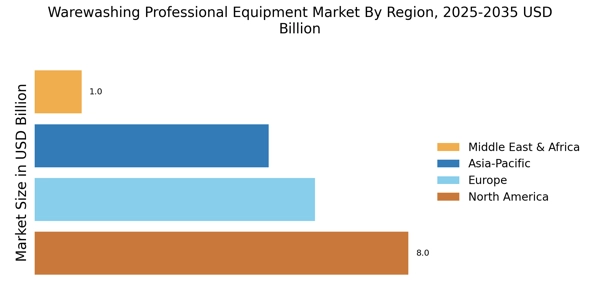Rising Food Service Sector
The expansion of the food service sector is significantly influencing the Warewashing Professional Equipment Market. As the number of restaurants, cafes, and catering services continues to grow, so does the demand for efficient and reliable warewashing solutions. Market data reveals that the food service industry is projected to experience robust growth, which in turn drives the need for advanced warewashing equipment capable of handling increased volumes. This trend presents opportunities for manufacturers to develop specialized products tailored to the unique needs of food service operators. Consequently, the Warewashing Professional Equipment Market is likely to see a surge in innovation and product offerings to cater to this expanding market.
Sustainability Initiatives
The increasing emphasis on sustainability within the Warewashing Professional Equipment Market is driving demand for eco-friendly solutions. Businesses are increasingly adopting energy-efficient and water-saving equipment to reduce their environmental footprint. According to recent data, the market for sustainable warewashing solutions is projected to grow significantly, as companies seek to comply with stringent environmental regulations. This trend is not only beneficial for the planet but also enhances the brand image of businesses, appealing to environmentally conscious consumers. As a result, manufacturers are innovating to create products that meet these sustainability goals, thereby expanding their market share in the Warewashing Professional Equipment Market.
Technological Advancements
Technological advancements are reshaping the Warewashing Professional Equipment Market, with innovations such as smart dishwashers and automated systems gaining traction. These technologies enhance efficiency and reduce labor costs, making them attractive to businesses in the food service sector. The integration of IoT (Internet of Things) in warewashing equipment allows for real-time monitoring and maintenance, which can lead to significant cost savings. Market data indicates that the adoption of such technologies is expected to increase, as operators seek to streamline operations and improve service quality. Consequently, manufacturers are compelled to invest in research and development to stay competitive in the evolving Warewashing Professional Equipment Market.
Health and Safety Regulations
The heightened focus on health and safety regulations is a critical driver in the Warewashing Professional Equipment Market. As food safety standards become more stringent, businesses are compelled to invest in high-quality warewashing equipment that ensures thorough cleaning and sanitization. Compliance with these regulations is essential for maintaining operational licenses and avoiding penalties. Market analysis suggests that the demand for advanced warewashing solutions, which can effectively eliminate pathogens and contaminants, is on the rise. This trend is prompting manufacturers to innovate and offer products that not only meet but exceed regulatory requirements, thereby enhancing their position in the Warewashing Professional Equipment Market.
Consumer Preferences for Quality
Consumer preferences for quality and hygiene are increasingly shaping the Warewashing Professional Equipment Market. As diners become more discerning about cleanliness and food safety, restaurants and food service providers are investing in high-performance warewashing equipment. This shift is driven by the need to meet customer expectations and maintain a competitive edge. Market Research Future indicate that businesses that prioritize quality in their operations are more likely to attract and retain customers. Therefore, manufacturers are focusing on developing equipment that not only meets hygiene standards but also enhances the overall dining experience. This trend underscores the importance of quality in the Warewashing Professional Equipment Market.


















Leave a Comment